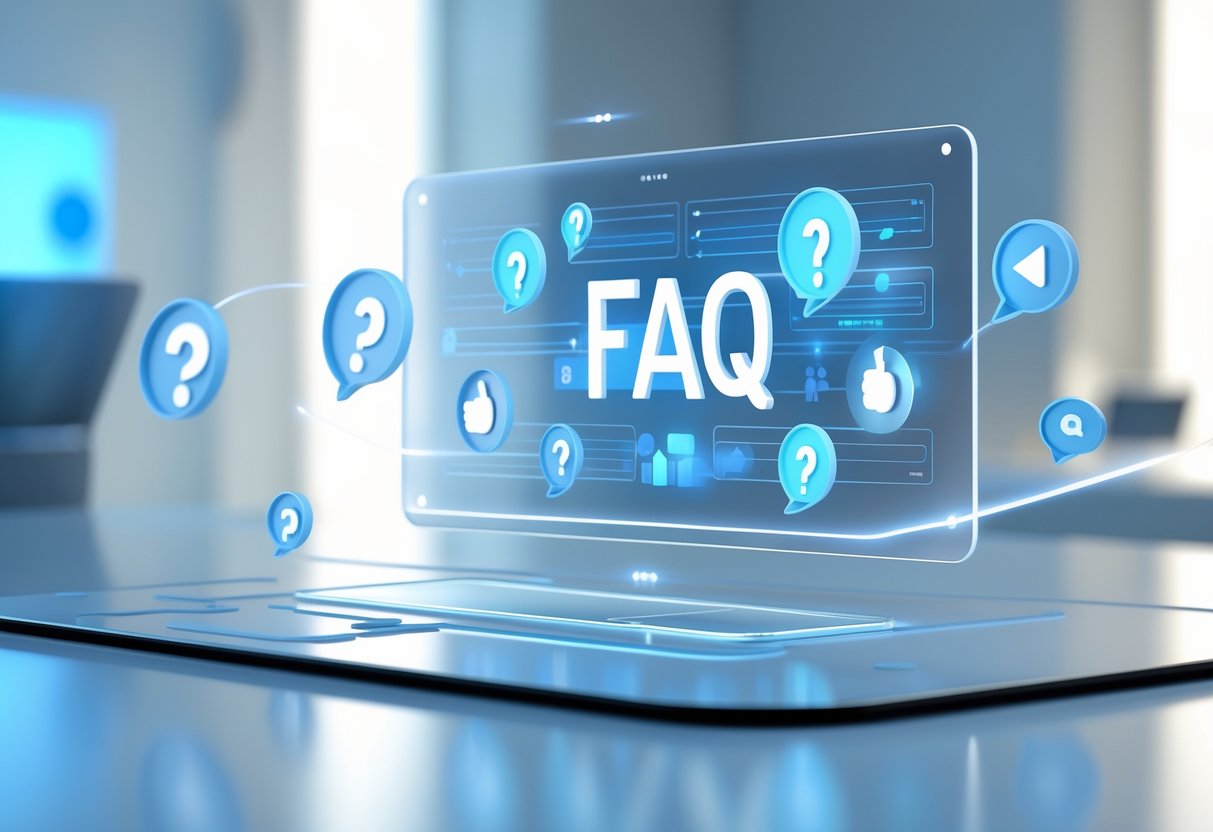Feedback Delivery: Best Practices for Effective Communication
Updated On: October 26, 2025 by Aaron Connolly
Understanding Feedback Delivery
Feedback delivery is all about giving clear information on someone’s performance or behaviour to help them improve.
Getting feedback right means picking the right time, tone, and approach so your message actually lands and makes a difference.
Defining Feedback Delivery
When you deliver feedback, you give someone specific info about what they’ve done or how they’ve performed.
It’s not just sharing opinions or tossing out criticism.
Good feedback points to what really happened.
You talk about what went well and what needs to shift.
The goal? Help people learn and get better at what they do.
Key elements of feedback delivery:
- Clear, specific examples
- Honest but respectful tone
- Focus on behaviours, not personality
- Suggestions for improvement
When you handle feedback well, you open up a two-way conversation.
The person getting feedback can ask questions and talk through next steps.
That makes your feedback a lot more useful and easier to act on.
Importance in Professional Settings
Giving feedback well matters for every team.
If people don’t get feedback, they have no idea if they’re on track or missing the mark.
Teams that share feedback a lot tend to perform better.
They catch problems sooner and don’t keep making the same mistakes.
That means better work and stronger results.
Benefits of effective feedback:
- Improved individual performance
- Stronger team relationships
- Faster problem-solving
- Reduced workplace stress
- Better job satisfaction
A lot of managers struggle with giving feedback.
They worry about hurting feelings or starting conflict.
But if you avoid feedback, you end up with bigger problems.
People need to know where they stand to do their best.
Regular feedback stops small issues from growing into disasters.
It also helps highlight good work, which keeps people motivated.
Core Principles of Effective Feedback
Be specific and timely. Give feedback soon after the event.
Use real examples, not just “you need to improve.”
Focus on actions, not character. Say “you interrupted three times in the meeting” instead of “you’re rude.”
That keeps it actionable and less personal.
Pick the right setting. Choose a private space for tough talks.
Make sure there’s enough time to really discuss things—not just a rushed chat.
| Do | Don’t |
|---|---|
| Give specific examples | Use vague language |
| Focus on behaviour | Attack personality |
| Choose private setting | Give feedback publicly |
| Listen to responses | Make it one-way |
| Suggest solutions | Only point out problems |
Make it a conversation. Ask questions and listen to their side.
Sometimes, people have reasons for what they did that you didn’t know about.
End with clear next steps. Agree on what will change and when you’ll check back.
That way, feedback actually leads to action.
Key Characteristics of Effective Feedback
Effective feedback has three qualities that really make a difference.
These traits help your message land and actually spark improvement, especially in competitive gaming.
Clarity and Specificity
Clear feedback targets real behaviours, not just vague impressions.
Instead of saying “your aim needs work,” describe a moment: “In the third round on Dust2, you missed three easy shots on enemies who weren’t moving.”
Specific feedback covers:
- Exact moments something happened
- Observable actions you saw
- Clear impact of those actions
This style helps players know exactly what went wrong and what they did right.
If you just say “play better,” your teammate won’t know what to fix.
James Connolly, a gaming coach, says the best coaches break down gameplay frame by frame.
They point to decision points where different choices could have changed everything.
Example comparison:
| Vague Feedback | Specific Feedback |
|---|---|
| “Your positioning is bad” | “You stood in the open at mid without cover, letting their sniper pick you off twice” |
| “Good job today” | “Your callouts in rounds 8-12 helped us win three clutch situations” |
Timeliness and Relevance
Fresh feedback hits harder than stuff you bring up days later.
Bring up gameplay issues right after rounds or matches, while details are still clear.
Best timing:
- During breaks between rounds
- Right after matches (within 30 minutes)
- Regular check-ins for ongoing growth
If you wait too long, people forget the details.
Players struggle to remember moments from days-old matches.
Quick feedback also helps learning stick.
If you highlight a great play right away, teammates connect what they did with the good result.
That builds confidence and makes them want to repeat it.
Heads up: Don’t interrupt live gameplay to give feedback.
Wait for a natural break so you don’t throw off their focus.
Behaviour-Focused Communication
Aim feedback at things people can control.
Talk about what happened, not who someone is.
Focus on behaviours:
- “You rotated too early” instead of “you’re impatient”
- “Your communication was clear” rather than “you’re a good leader”
- “Try checking corners more slowly” not “you’re too aggressive”
This keeps people from getting defensive and keeps the talk productive.
Most folks prefer criticism about specific actions, not about who they are.
When feedback is about actions, it’s easier to know what to improve next time.
Preparing for Feedback Delivery
Getting ready matters.
Preparation turns feedback into something useful instead of something forgettable.
You need clear goals and a sense of how to reach each person.
Setting Intentions and Objectives
Before you sit down to give feedback, know what you want to accomplish.
Are you fixing a problem, recognising good work, or helping someone grow?
Clear objectives keep you focused. Write down your main point.
Maybe it’s “Help Sarah improve her project updates” or “Recognise Tom’s teamwork last week.”
Gather your facts before you start.
Collect specific examples, check dates, and review relevant work.
Vague feedback like “you need to do better” doesn’t help anyone.
Set realistic expectations for what one chat can do.
You can’t solve months of problems in one meeting.
Pick one or two key things that matter most.
Think about timing.
Feedback works best when it’s close to the event.
If you wait too long, everyone forgets the details.
Tailoring Feedback for Individuals
Different people need different feedback styles.
What motivates one teammate might totally discourage another.
Consider their experience. New folks need more guidance and encouragement.
Experienced people usually want direct, specific feedback.
Some prefer written notes they can review later.
Others want a real conversation.
Pay attention to what works for each person.
Think about their career goals. Someone aiming for leadership wants feedback on delegation and decision-making.
Someone focused on technical skills wants to know about their expertise.
Watch their workload and stress.
If someone’s already slammed with deadlines, they might not be ready for big-picture feedback.
Sometimes you need to handle urgent stuff first.
Cultural differences count too.
Some backgrounds find direct feedback harsh, while others expect it.
Establishing a Feedback-Friendly Team Culture
Building a team culture where people feel comfortable sharing honest feedback takes real effort.
You need to open up communication and build trust.
These two things make feedback flow naturally, both ways.
Encouraging Open Communication
Open communication means making feedback a regular thing, not just something you do at reviews.
Regular check-ins create chances for feedback.
Weekly meetings, project retros, or even casual chats work.
Leaders should set the example by asking for input.
Questions like “What could we do differently next time?” or “How did that process work for you?” show everyone’s voice matters.
Anonymous feedback channels let folks share tough truths without fear.
Suggestion boxes or anonymous surveys help people speak up when they might not otherwise.
Set clear ground rules for feedback.
That way, people know when and how to give it, and feel more confident.
Training sessions on feedback delivery help too.
A lot of people avoid giving feedback simply because they’re not sure how.
Building Trust Within Teams
Trust is the foundation for any feedback-friendly team.
Without psychological safety, even great feedback systems fall flat.
Consistent responses build trust over time.
Leaders should respond supportively, whether the feedback is positive or tough to hear.
Show that feedback leads to real action.
When people see their suggestions taken seriously, they’re more likely to speak up next time.
Protect confidentiality for sensitive feedback.
Team members need to know their words won’t be used against them.
Celebrate wins where feedback led to real change.
Share stories about how team input made things better.
Leaders should also talk about their own growth areas.
When managers admit where they’re working to improve, it makes feedback normal for everyone.
Choosing the Right Environment for Feedback

Where you give feedback matters a lot.
The right setting can make a tough conversation easier, while the wrong one can ruin it.
You need to know when to keep things private and how to make people feel safe enough to talk honestly.
Private Versus Public Feedback
Private feedback is usually best.
When you talk about performance issues or areas for improvement, one-on-ones protect dignity and encourage honesty.
Save private chats for sensitive stuff—missed deadlines, skill gaps, or behaviour issues.
Public recognition works for celebrating wins.
Praise achievements in team meetings or company emails.
Use public feedback to:
- Celebrate wins in front of peers
- Share stories that inspire others
- Highlight teamwork that deserves a shoutout
But never criticise someone in public.
That destroys trust and makes future feedback way harder.
Pick neutral spots for tough talks.
Meeting rooms are better than your office, which can feel intimidating.
Virtual meetings can also help remote folks feel less pressure.
Creating Safe Spaces for Discussion
Physical comfort actually matters.
Get rid of barriers like desks between you and the other person.
Arrange chairs at angles, not straight across.
Make sure you have privacy—close the door and silence notifications.
Interruptions send the message that something else is more important.
Start with a neutral, open approach.
Say “I noticed the project timeline shifted” instead of “You’re behind schedule.”
Let people know feedback goes both ways.
Ask for their side first.
Listen without jumping in.
Acknowledge good points they make.
Share your own struggles with similar challenges.
Be clear about confidentiality.
Let folks know what stays between you and what might need to be shared.
That transparency builds trust for next time.
Set up regular feedback rhythms.
Weekly check-ins help you catch issues early, before they snowball.
Feedback Delivery Techniques

Delivering feedback well means picking the right approach for the moment.
The best techniques build trust and give people clear, doable advice they can actually use.
Balanced and Constructive Approaches
Traditional feedback often falls short because it zeroes in on what went wrong. These days, people really value balance and a focus on growth.
The Start, Stop, Continue method helps structure tough conversations. We ask team members to start one thing, stop another, and keep doing something that works. This keeps the focus even between what to improve and what already goes well.
Key components of balanced feedback:
- Specific observations instead of vague comments
- Impact explanations so people see how their actions affect others
- Future-focused suggestions to guide improvement
- Recognition for what’s working
The feedback wrap technique gives more context than just criticism. We lay out the situation, share what we noticed, explain how we felt, say what we need, and then ask for ideas.
We use this approach to avoid blame. Instead of “you always interrupt,” we might say, “In today’s meeting, I noticed three interruptions during my presentation, which made me feel unheard.”
The Feedforward Method
Feedforward puts the spotlight on future possibilities instead of past mistakes. Rather than rehashing what went wrong, we look at what could go right.
This method really helps with defensive team members. Instead of picking apart failures, we might ask, “What would success look like next time?” or “How could we handle this differently?”
Feedforward conversation structure:
- Acknowledge the situation without harsh criticism
- Ask for their perspective on what happened
- Explore future scenarios together
- Agree on specific actions for next time
People tend to get less defensive with this method. Emotional resistance drops when we focus on the future, not the past.
We might say, “Let’s talk about your next client presentation. What three things would make it more impactful?” This encourages collaborative problem-solving instead of one-sided criticism.
Research says feedforward sparks more actionable ideas than old-school feedback. Team members leave these talks feeling energized about what’s ahead.
Navigating Difficult Conversations

Feedback conversations sometimes get tense. When that happens, staying calm and focused really matters. The main thing is managing defensive reactions and keeping things both respectful and productive.
Addressing Defensiveness
People often get defensive when they hear feedback. Our brains naturally want to shield us from criticism.
Spot the signs early. Watch for crossed arms, interruptions, or comments like “That’s not what happened.” When you notice these, pause the conversation.
Try the “acknowledge and redirect” move. Something like, “I can see this is frustrating. Help me understand your view on what happened,” can help.
Ask open questions rather than making more statements. For example, “What was going through your mind during that meeting?” works better than “You seemed unprepared.”
Give people a moment to process. Some folks need a bit of time to get past their first reaction.
Switch to feedforward if defensiveness spikes. Focus on what can improve next time. Ask, “What would help you handle this differently next time?”
If things get too heated, suggest a break. Saying, “Let’s pause for a few minutes and come back to this,” keeps the conversation from going off the rails.
Maintaining Professionalism and Empathy
Keep your tone steady and neutral, even if emotions start to bubble up. This helps the other person feel safer and more open.
Start with your intention. Try: “I’m sharing this because I want to see you succeed,” or, “This feedback could help you grow in your role.”
Use “I” statements to avoid sounding accusatory. “I noticed the deadline was missed” feels less harsh than “You missed the deadline.”
Show you care about them as a person. Mention their strengths before diving into what needs work.
Listen actively when they respond. Nod, ask follow-ups, and repeat back what you hear: “So you’re saying the workload made it difficult to focus?”
Talk about specific behaviours, not personality traits. Stick to what they did or didn’t do—not who they are.
Wrap up with clear next steps and offer support. “What resources would help you improve this?” shows you’re rooting for them.
Leveraging Feedback for Continuous Improvement

Feedback only helps us grow if we actually use it to make changes. We can turn feedback into personal development gains and real progress for gaming organizations.
Linking Feedback to Personal Development
Personal growth happens when we act on feedback. Creating a clear plan that links what we hear to what we do next really matters.
Start by sorting feedback into three buckets: technical skills, communication, and teamwork. This helps us focus where it counts.
Set up regular check-ins with mentors or team leaders for accountability. We track progress every week and adjust our approach as needed.
Quick win: Keep a feedback journal. Write down one specific improvement goal each week. Turning general comments into action steps works wonders.
Pro gamers often use feedback to spot weak points first. They spend most of their practice time on those gaps instead of polishing strengths.
Ask for more feedback after making changes. This keeps the improvement loop going and builds momentum.
Driving Organisational Growth
Teams get stronger when feedback flows in all directions. We need systems that gather insights from players, coaches, and support staff all the time.
Top gaming organizations use structured feedback sessions after every big tournament or training block. They look at what worked, what didn’t, and plan specific changes.
Safe spaces matter so people can share honestly. This might mean anonymous surveys or small group chats before big team meetings.
Heads up: Don’t collect feedback and then ignore it. That kills trust and makes people clam up in the future.
Smart organizations track feedback trends over time. If a bunch of people mention the same issue, it jumps to the top of the list.
We can also check our feedback habits against top esports teams. Many share their methods in interviews and case studies online.
Regular feedback reviews help spot patterns. Teams can make smarter decisions about training, roster changes, and getting ready for competitions.
Integrating Feedback within the Workplace

To build feedback into your workplace, set up regular review cycles and make feedback part of daily routines. This keeps conversations going and helps teams get stronger.
Regular Feedback Cycles
Weekly one-on-ones beat yearly reviews for most teams. Set up 30-minute chats where managers and team members talk about projects and challenges.
Schedule feedback at regular times. Monday mornings set the tone for the week, while Friday afternoons let teams reflect and wrap up.
Monthly team sessions bring everyone together. Use these meetings to:
- Tackle team-wide challenges
- Celebrate wins
- Plan next steps
Quarterly reviews zoom out to bigger goals and career growth. These longer meetings give space to talk about skill development and future plans.
Track feedback frequency so you stay consistent. Many top companies aim for weekly informal feedback and monthly formal reviews.
If urgent issues pop up, don’t wait. Handle them right away so small problems don’t turn into big ones.
Embedding Feedback in Company Processes
Work feedback into your everyday routines, not just special events. Add feedback to project kick-offs and wrap-ups.
Put feedback on meeting agendas for quick wins and improvement ideas. Just five minutes can keep feedback flowing.
Train all managers on how to give feedback. Bad delivery can hurt trust. Focus on clear examples and next steps.
| Process | Feedback Integration |
|---|---|
| Project reviews | Discuss what worked and what didn’t |
| Team meetings | Share wins and learning opportunities |
| Goal setting | Include feedback on past performance |
Use feedback forms for structure. Simple templates help people gather their thoughts before discussions.
Offer different feedback channels. Some people like written notes, others prefer face-to-face. Email, surveys, and team tools all have their place.
Document key feedback to track progress. This helps employees see their growth and reminds managers what was discussed before.
Utilising Technology for Feedback Delivery

Technology is changing how we collect and use feedback in esports teams. Digital platforms automate the process, and analytics tools help us spot patterns that can boost performance and team dynamics.
Digital Feedback Tools and Platforms
We’ve got lots of digital feedback platforms to choose from in esports. Survey tools like Google Forms or Typeform are great for quick post-match reviews. They’re free and plug right into existing workflows.
Real-time feedback platforms gather instant reactions during scrims or tournaments. Discord bots can grab quick thoughts from coaches and teammates. Slack integrations sort feedback by player or session.
Pro esports organizations often use 360-degree feedback platforms. These gather input from coaches, teammates, analysts, and staff. The data builds detailed player profiles highlighting strengths and areas to work on.
Video review platforms like GameTape or Insights.gg mix match recordings with feedback. Coaches can tag moments and add comments right on the footage. Players get both visual context and written notes, making changes easier.
Mobile apps let teams collect feedback anywhere. Players can respond while traveling or between matches. Push notifications remind them to fill out evaluations without messing up their schedule.
Analysing Feedback Data
Raw feedback doesn’t mean much until we analyze it. Sentiment analysis tools sort responses as positive, negative, or neutral. This saves tons of time, especially after big tournaments.
We use spreadsheets or analytics platforms to find trends. Look for common themes or repeated performance issues. Visual dashboards make patterns pop more than long reports.
Machine learning algorithms can even predict future problems based on past feedback. If lots of players mention communication issues, the system flags possible chemistry problems before they hurt results.
Segmenting the data gives us deeper insights. We can group feedback by player role, match type, or timeframe. Supports might need different feedback than carries. Feedback after a loss usually looks different from after a win.
Automated reports pull together weekly or monthly summaries. These highlight where to improve and track progress. Coaches get the big picture without wading through piles of responses.
Adapting Feedback Approaches for Diverse Teams

Team members from different cultural backgrounds and neurotypes process feedback in their own ways. When we understand and adapt to these differences, communication gets better and teams build stronger relationships.
Cultural Considerations in Feedback
Culture shapes how people hear feedback—tone, directness, even timing. What feels helpful to one person might feel harsh to someone else.
Direct vs. Indirect Communication Styles
Some cultures value direct, straight-to-the-point feedback. Others prefer softer suggestions and positive framing.
Western cultures often want clear, specific criticism. Many Asian and African cultures lean toward gentle approaches that protect dignity.
Power Distance and Hierarchy
Team members from high power distance cultures might find peer feedback tough. They expect guidance mainly from managers or senior staff.
Keep these cultural preferences in mind:
- Individual vs. group settings: Some want private talks
- Written vs. verbal delivery: Written feedback gives time to think
- Formal vs. casual tone: Match the formality to what feels right
Time Orientation Differences
Cultures see time and deadlines differently. Timing of feedback can really matter.
Some cultures see immediate feedback as helpful. Others need to build trust before accepting criticism.
Inclusive Feedback Strategies
Giving feedback on diverse teams means using different delivery methods and tailoring your approach. You can’t expect one style to work for everyone.
Personalised Delivery Methods
Offer feedback options that match people’s preferences and needs:
| Method | Best For | When to Use |
|---|---|---|
| Face-to-face | Relationship builders | Complex issues |
| Written | Processors, introverts | Detailed feedback |
| Group discussion | Collaborative cultures | Team improvements |
| Structured forms | Detail-oriented people | Regular check-ins |
Neurodiversity Considerations
Neurodiverse teammates process information in their own ways. Autistic colleagues usually want clear, specific language without any hidden messages.
ADHD team members do better with short, focused sessions. They need clear action steps and reminders afterward.
Building Inclusive Feedback Systems
Set clear expectations for how often you’ll give feedback and in what format. Let people pick their preferred methods when you can.
Give everyone some time to process feedback before expecting a response. Not everyone thinks on their feet.
Talk about specific actions instead of personality traits. Use phrases like “I noticed” instead of “You always.”
Train managers to spot their own cultural biases. What feels natural to one person might not land well for someone else.
Ask for feedback on the feedback process itself. Team members can tell you what works and what just feels awkward.
Overcoming Common Feedback Barriers

Even experienced teams hit snags with feedback when people start resisting or messages get muddled. The best approach? Notice when folks shut down and adjust how you communicate.
Handling Feedback Resistance
Fear, not defiance, usually causes resistance. When someone gets defensive, switch up your approach right away.
Start with self-assessment questions to lower defenses. Ask, “How do you think that round went?” before sharing your thoughts. This lets them steer the conversation a bit.
Focus on actions, not personality. Instead of “You’re too aggressive,” try “When you pushed forward without cover, the team got split up.” That way, it feels less personal.
Stick to the two-piece rule for corrective feedback. Only bring up one or two issues per session. More than that can overwhelm folks and shut them down.
Make room for bidirectional conversation by asking how they want to get feedback. Some people like written notes, others need quick verbal tips during gameplay.
If someone pushes back, acknowledge their side first: “I can see why you felt that call was right.” This shows respect before you suggest alternatives.
Avoiding Miscommunication
Clear communication stops most feedback problems before they start. We often think others get our intentions, but that’s not always true.
Frame feedback as your perspective, not the absolute truth. Say “I noticed the team coordination broke down” instead of “You didn’t communicate properly.” That keeps things less tense.
Get specific with timing and context. Vague feedback like “improve your positioning” doesn’t help anyone. Try, “In that final team fight, staying closer to our tank would have kept you alive longer.”
Check understanding right after giving feedback. Ask them to repeat what they heard or explain how they’ll make changes.
Use visual examples when you can. Watch gameplay footage together or sketch out ideas on a whiteboard. A lot of people learn better by seeing, not just hearing.
Separate feedback from emotions by taking a break if things get heated. If you’re frustrated, wait until you’ve cooled off before bringing up the mistake.
Frequently Asked Questions

Giving feedback well means balancing honesty with tact, and timing with compassion. Here are some common questions and practical tips for making feedback less stressful and more useful for everyone.
What are some tactful ways to provide professional feedback?
Ask permission before jumping into feedback. Try, “Would it be helpful if I shared an observation from today’s meeting?” That gives the other person a moment to get ready.
Talk about specific actions, not personality traits. Say, “I noticed the project timeline wasn’t ready for today’s discussion,” instead of “You’re disorganised.”
Use “I” statements to own your view. “I found it difficult to follow the presentation structure” doesn’t sound as harsh as “Your presentation was confusing.”
Pick private settings for developmental feedback. Public criticism can embarrass people and wreck trust.
Tie feedback to shared goals. “This could help us hit our quarterly targets” shows you care about the same things.
Can you give some examples of effective feedback practices?
Positive feedback examples:
- “Your client email yesterday was brilliant—you addressed their concerns directly and offered three concrete solutions.”
- “The way you handled that difficult question in the presentation showed real expertise.”
Developmental feedback examples:
- “During yesterday’s team call, you interrupted Sarah twice. I think giving space for others to finish their thoughts could strengthen team dynamics.”
- “Your report had great insights, but the executive summary ran quite long. Could we try keeping it to one page next time?”
Peer-to-peer feedback:
- “I noticed you seemed stressed during our handoff meeting. Is there something I could do differently to make our collaboration smoother?”
All these examples focus on actions and give clear ideas for how to improve.
What are the various forms of feedback that can be utilised in the workplace?
Informal feedback pops up in the moment. Quick comments like “Great job on that client call” or “Could you double-check those figures?” keep things moving.
Formal feedback happens during reviews, one-to-ones, or team meetings. This covers performance evaluations and development talks.
Peer feedback goes between colleagues at the same level. It works well for projects and cross-team work.
360-degree feedback pulls in opinions from managers, peers, and direct reports. You get a bigger picture this way.
Written feedback sticks around and lets you choose your words carefully. Email summaries after a chat make things clearer.
Real-time feedback deals with stuff right away. It stops little problems from turning into big ones.
How can one ensure that their feedback is constructive and beneficial?
Check your motive before you speak. Ask yourself, “Am I trying to help this person grow, or am I just venting?”
Use the SBI model: Situation, Behaviour, Impact. For example, “In this morning’s client meeting (situation), when you arrived fifteen minutes late (behaviour), it made us look unprepared to the client (impact).”
Mix developmental feedback with recognition. People need to hear what they’re doing right, not just what’s wrong.
Make feedback actionable. Suggest a next step, like “Next time, could you send the agenda a day in advance?”
Ask questions to get them reflecting. “What do you think went well in that presentation?” helps them self-assess.
Follow up after giving feedback. Check in a few days later to see how things are going.
Could you share some techniques for successfully exchanging feedback with colleagues?
Timing matters a lot. Don’t give feedback when emotions are high or when someone’s rushing off.
Create psychological safety by starting with something positive. “I really appreciated your thoroughness on this project” opens the door for honest conversation.
Be careful with the feedback sandwich. Some people want directness instead of the positive-negative-positive routine.
Practice active listening when they respond. Feedback should be a two-way street.
Make feedback normal by asking for input on your own work. “How did you feel that meeting went? Is there anything I could do differently?”
Set regular check-ins with teammates so feedback becomes routine, not a surprise.
What methods can be used to ensure positive feedback is both encouraging and useful?
Point out exactly what someone did well. Instead of saying, “You handled that difficult customer brilliantly,” try, “You stayed calm when the customer raised their voice and asked clarifying questions to understand their real concern.” That way, your feedback actually means something.
Let them know how their positive actions help the team. For example, “Your detailed notes from client meetings help the whole team stay aligned between sessions.” People usually like to hear how their work matters, right?
Tie your feedback back to their goals. If they’re working on leadership skills, call out the times you saw them step up as a leader.
Give feedback quickly, while the moment is still fresh for everyone. No need to wait for those formal review cycles—just say it when you see it.
Sometimes, it’s good to share positive feedback in front of others. Recognizing someone’s contribution in a team meeting can really boost morale and set the tone.
Ask them to think about what worked. Questions like, “What do you think made that client presentation so effective?” help them see and repeat their strengths.

